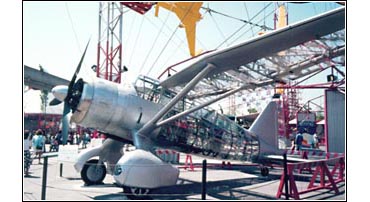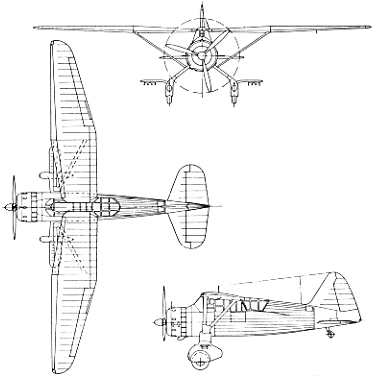
Westland Lysander Mk III
The Lysander was designed in the mid-1930s as a two-seat army cooperation airplane, with its first flight in June 1936. Its wartime duties qualified it for inclusion as a combat type. Armament consisted of one 0.303 in Browning machine gun operated by the pilot, in each wheel spat, firing outside the propeller disc, and a free Browning in the rear cockpit. Twelve small antipersonnel bombs could be carried under small stub-wings fitted to the spats.
1,372 Lysanders were built on a cottage industry basis in Britain. Parts were built by small firms and individuals and trucked to locations where they were assembled into components These parts were taken to yet another location where they were assembled into an airplane. Canadian production of the Lysander began in Malton, Ontario in October 1938, with the first flight in August 1939. 225 were built there and another 104 Lysanders were shipped over from the U.K. Most of the world's few surviving Lysanders are ex-RCAF.
Lysanders were affectionately know as "Lizzies" and their distinctive appearance caused some people to divide aircraft into two classes - airplanes and Lysanders! During the war they were used for ground attack, target towing, glider towing and air-sea rescue, the latter duty involved dropping rubber rafts and survival packs.
Despite its appearance, the Lysander was aerodynamically advanced with automatic wing slats, slotted flaps and a variable incidence tailplane. These refinements gave the Lysander a very low stalling speed. One of the original STOL (Short Take Off and Landing) designs, the Lysander could land and take off in the length of a football field. The RAF Lysander III was fitted with a long-range fuel tank and a side ladder, and used to transport Allied agents into enemy occupied territory.

The CMF gathered parts to assemble one of these very rare airplanes from 7 different locations, ranging from Texas to Manitoba, Saskatchewan, Alberta and Vancouver Island.
Eventually the massive job of restoring the airplane began in late December, 1985. This impressive restoration was accomplished in less than 4 months almost entirely by volunteers under the direction of Mark Zalesky, for display at Expo 86 (as shown in the above photo). Covered in clear plastic sheeting to create the "Gossamer Lysander" at Expo's request, it was featured in the Aviation Plaza. It is currently on display in the museum hangar at Langley Airport. The basic components were donated by the Zalesky family in 1986.
Technical Details:
Serial: 1194, RCAF 2349
Manufactured: 1942 at Toronto, Ontario by National Steel Car
Maximum speed: 230 mph (370 km/h)
Stall speed: under 60 mph (96 km/h)
Empty weight: 4,260 lb (1932 kg)
Loaded weight: 6,000 lb (2,724 kg)
Span: 50 ft (15.2 m)
Length: 30 ft 6 in (9.3 m)
Height: 11 ft 6 in (3.5 m)
Wing area: 260 sq ft (24.1 sq m)
